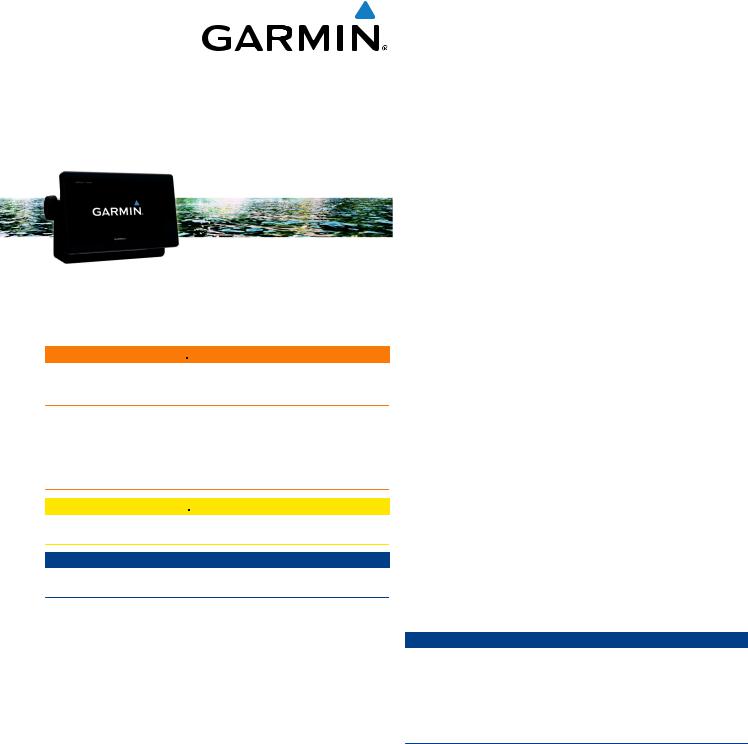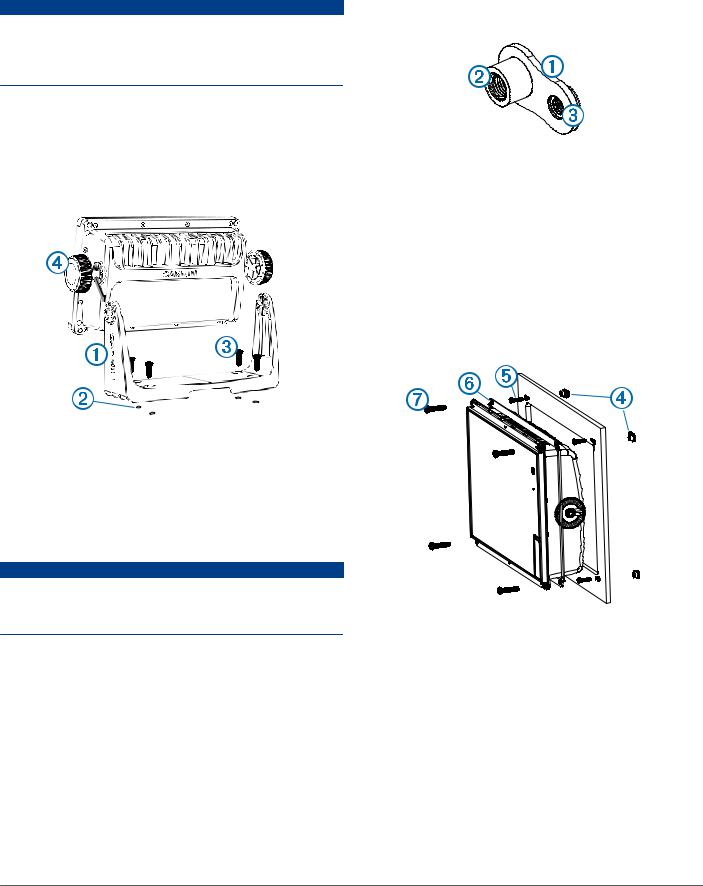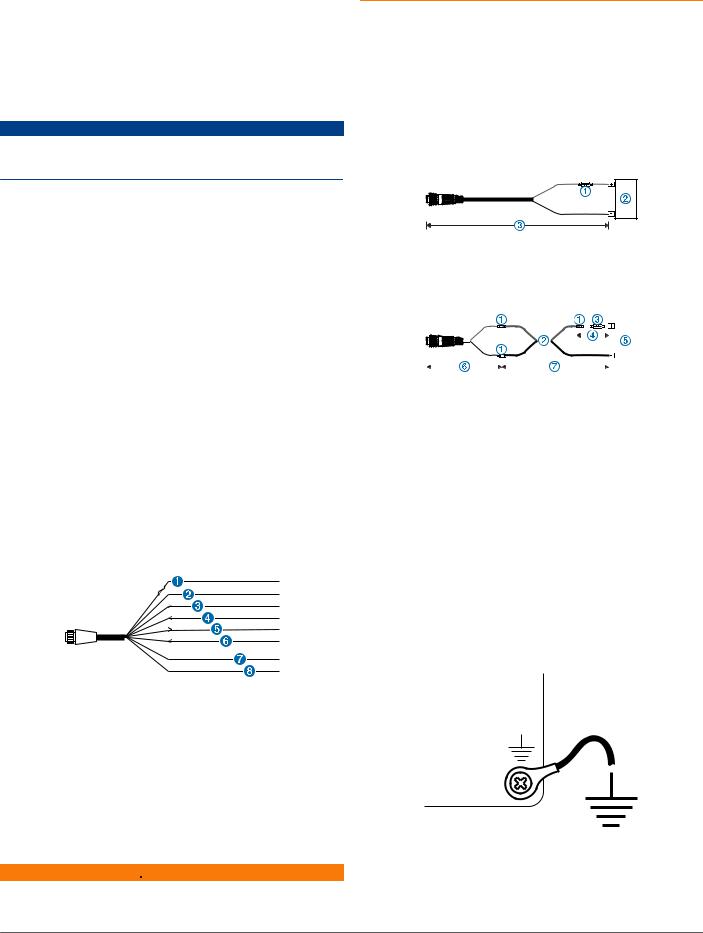Garmin GPSMAP 7407xsv, GPSMAP 7408xsv, GPSMAP 7410xsv, GPSMAP 7412xsv, GPSMAP 7416xsv Installation Instructions
...
GPSMAP® 7400/7600
Series
Installation Instructions
Important Safety Information
 WARNING
WARNING
See the Important Safety and Product Information guide in the product box for product warnings and other important information.
When connecting the power cable, do not remove the in-line fuse holder. To prevent the possibility of injury or product damage caused by fire or overheating, the appropriate fuse must be in place as indicated in the product specifications. In addition, connecting the power cable without the appropriate fuse in place will void the product warranty.
 CAUTION
CAUTION
Always wear safety goggles, ear protection, and a dust mask when drilling, cutting, or sanding.
NOTICE
When drilling or cutting, always check what is on the opposite side of the surface.
To obtain the best performance and to avoid damage to your boat, install the device according to these instructions.
Read all installation instructions before proceeding with the installation. If you experience difficulty during the installation, contact Garmin® Product Support.
Registering Your Device
Help us better support you by completing our online registration today.
•Go to http://my.garmin.com.
•Keep the original sales receipt, or a photocopy, in a safe place.
Contacting Garmin Product Support
•Go to www.garmin.com/support for in-country support information.
•In the USA, call 913-397-8200 or 1-800-800-1020.
•In the UK, call 0808 238 0000.
•In Europe, call +44 (0) 870 850 1241.
Software Update
You may need to update the device software when you install the device or add an accessory to the device.
Loading the New Software on a Memory Card
1 Insert a memory card into the card slot on the computer. 2 Go to www.garmin.com/support/software/marine.html.
3Select Download next to "Garmin Marine Network with SD card."
4 Read and agree to the terms.
5 Select Download.
6 Select Run.
7Select the drive associated with the memory card, and select
Next > Finish.
Updating the Device Software
Before you can update the software, you must obtain a software-update memory card or load the latest software onto a memory card.
1 Turn on the chartplotter.
2After the home screen appears, insert the memory card into the card slot.
NOTE: In order for the software update instructions to appear, the device must be fully booted before the card is inserted.
3 Follow the on-screen instructions.
4Wait several minutes while the software update process completes.
The device returns to normal operation after the software update process is complete.
5Remove the memory card.
NOTE: If the memory card is removed before the device restarts fully, the software update is not complete.
Tools Needed
•Drill and drill bits
◦Bail mount: drill bits appropriate for the surface and hardware
◦Flush mount: 13 mm (1/2 in.) drill bit, 7.2 mm (5/16 in.), and 3.5 mm (1/8 in.) drill bit
•#2 Phillips screwdriver
•Jigsaw or rotary tool
•File and sandpaper
•Marine sealant (recommended)
Mounting Considerations
NOTICE
This device should be mounted in a location that is not exposed to extreme temperatures or conditions. The temperature range for this device is listed in the product specifications. Extended exposure to temperatures exceeding the specified temperature range, in storage or operating conditions, may cause device failure. Extreme-temperature-induced damage and related consequences are not covered by the warranty.
Using the included hardware and template, you can mount the device using one of two methods. You can use the included bracket and hardware to bail mount the device, or you can use the included template and hardware to flush mount the device in the dashboard.
When selecting a mounting location, you should observe these considerations.
•The location should provide optimal viewing as you operate your boat.
•The location should allow for easy access to all device interfaces, such as the keypad, touchscreen, and card reader, if applicable.
•The location must be strong enough to support the weight of the device and protect it from excessive vibration or shock.
•To avoid interference with a magnetic compass, the device should not be installed closer to a compass than the
December 2014 |
Printed in Taiwan |
190-01841-02_0A |

compass-safe distance value listed in the product specifications.
•The location must allow room for the routing and connection of all cables.
Bail Mounting the Device
NOTICE
If you are mounting the bracket on fiberglass with screws, it is recommended to use a countersink bit to drill a clearance counterbore through only the top gel-coat layer. This will help to avoid any cracking in the gel-coat layer when the screws are tightened.
The bail-mounting hardware (screws and washers, or nuts, washers, and bolts) is not included. Before you can bail mount the device, you must choose mounting hardware that fits the holes in the bail mount bracket and securely attaches it to your specific mounting surface. The size of the pilot holes required depends on the mounting hardware you choose.
1 Using the included bail mount bracket as a template, mark
À
the location of the four pilot holes .
Á
2Using a drill bit appropriate for your mounting hardware, drill the pilot holes.
3 Secure the bail mount bracket to the surface using your mounting hardware .
Â
4 Install the bail mount knobs on the sides of the device.
Ã
5Place the device in the bail mount bracket, and tighten the bail mount knobs.
Flush Mounting the Device
NOTICE
Be careful when cutting the hole to flush mount the device. There is only a small amount of clearance between the case and the mounting holes, and cutting the hole too large could compromise the stability of the device after it is mounted.
The included template and hardware can be used to flush mount the device in your dashboard.
1Trim the template, and make sure it fits in the location where you want to mount the device.
2 Secure the template to the selected location.
3Using a 13 mm (1/2 in.) drill bit, drill one or more of the holes inside the corners of the solid line on the template to prepare the mounting surface for cutting.
4Using a jigsaw or a rotary tool, cut the mounting surface along the inside line on the template.
5 Place the device in the cutout to test the fit.
6If necessary, use a file and sandpaper to refine the size of the cutout.
7After the device fits correctly in the cutout, ensure the
mounting holes on the device line up with the larger 7.2 mm (5/16 in.) holes on the template.
8If the mounting holes on the device do not line up, mark the new hole locations.
9 Using a 7.2 mm (5/16 in.) drill bit, drill the larger holes. 10Starting in one corner of the template, place a nut plate
À
over the larger hole drilled in step 9.
Á
The smaller 3.5 mm (1/8 in.) hole on the nut plate should
Â
line up with the smaller hole on the template.
11If the smaller 3.5 mm (1/8 in.) hole on the nut plate does not line up with the smaller hole on the template, mark the new hole location.
12Repeat steps 10 and 11 to verify placement of the remaining nut plates and holes on the template.
13Using a 3.5 mm (1/8 in.) drill bit, drill the smaller holes. 14Remove the template from the mounting surface.
15Starting in one corner of the mounting location, place a nut plate on the back of the mounting surface, lining up the
Ã
large and small holes.
The raised portion of the nut plate should fit into the larger hole.
16Secure the nut plate to the mounting surface by fastening an
included M3 screw through the smaller 3.5 mm (1/8 in.)
Ä
hole.
17Repeat steps 15–16 to secure the remaining nut plates to the mounting surface.
18Install the rubber gasket on the back of the device.
Å
The pieces of the rubber gasket have adhesive on the back. Make sure you remove the protective liner before installing them on the device.
19If you will not have access to the back of the device after you mount it, connect all necessary cables to the device before placing it into the cutout.
NOTE: To prevent corrosion of the metal contacts, cover unused connectors with the attached weather caps.
20Apply marine sealant between the mounting surface and the device to properly seal and prevent leakage behind the dashboard.
2

21If you will have access to the back of the device, apply marine sealant around the cutout.
22Place the device into the cutout.
23Secure the device to the mounting surface using the included M4 screws .
Æ
24Wipe away all excess marine sealant.
25Install the decorative bezel by snapping it in place around the edges of the device.
Cable and Connection Considerations
NOTICE
If your model has a DVI port, a blue rubber seal is included. This seal must be installed between the DVI port and DVI cable connector to avoid damage to the connectors.
•For easer cable routing, the Garmin Marine Network cables, the power and NMEA® 0183 cables, and the transducer cable are packaged without the locking rings installed. You should route the cables before you install the locking rings.
•After connecting a locking ring to a cable, make sure the ring is securely connected and the o-ring is in place so the power or data connection remains secure.
About the Wiring Harness
•The wiring harness connects the device to power, NMEA 0183 devices, and a lamp or a horn for visible or audible alerts.
•The wiring harness is packaged without the locking ring installed. You should route the cable before you install the locking ring.
•After connecting a locking ring to the wiring harness, you should make sure the ring is securely connected and the o- ring is in place so the connection remains secure.
•The device has two internal NMEA 0183 ports that are used to connect to NMEA 0183 compliant devices. When connecting to a device for both transmitting and receiving, you must make sure to use wires from the same internal NMEA 0183 port.
•If it is necessary to extend the power and ground wires, you must use 16 AWG (1.31 mm²) wire.
•If it is necessary to extend the NMEA 0183 or alarm wires, you must use 22 AWG (.33 mm²) wire.
must be in place as indicated in the product specifications. In addition, connecting the power cable without the appropriate fuse in place will void the product warranty.
1Route the wiring harness to the power source and to the device.
2Connect the red wire to the positive (+) battery terminal, and connect the black wire to the negative (-) battery terminal.
3Install the locking ring and o-ring on the end of the wiring harness.
4Connect the wiring harness to the device by turning the locking ring clockwise.
Power Cable Extensions
If necessary, the power cable can be extended using the appropriate wire gauge for the length of the extension.
Item |
Description |
||||||||||||||||||||
À |
Fuse |
||||||||||||||||||||
|
|
|
|
|
|
|
|
|
|
|
|
|
|
|
|
|
|
|
|
|
|
Á |
Battery |
||||||||||||||||||||
|
|
|
|
|
|
|
|
|
|
|
|
|
|
|
|
|
|
|
|
|
|
 |
1.8 m (6 ft.) without extension |
||||||||||||||||||||
|
|
|
|
|
|
|
|
|
|
|
|
|
|
|
|
|
|
|
|
|
|
|
|
|
|
|
|
|
|
|
|
|
|
|
|
|
|
|
|
|
|
|
|
|
|
|
|
|
|
|
|
|
|
|
|
|
|
|
|
|
|
|
|
|
|
|
|
|
|
|
|
|
|
|
|
|
|
|
|
|
|
|
|
|
|
|
|
|
|
|
|
|
|
|
|
|
|
|
|
|
|
|
|
|
|
|
|
|
|
|
|
|
|
|
|
|
|
|
|
|
|
|
|
|
|
|
|
|
|
|
|
|
|
|
|
|
|
|
|
|
|
|
|
|
|
|
|
|
|
|
|
|
|
|
|
|
|
|
|
|
|
|
|
|
|
|
|
|
|
|
|
|
|
|
|
|
|
|
|
|
|
|
|
|
|
|
|
|
|
|
|
|
|
|
|
|
|
Item |
Description |
|
À |
Splice |
|
|
|
|
Á |
• 12 |
AWG (3.31 mm²) extension wire, up to 4.6 m (15 ft.) |
|
• 10 |
AWG (5.26 mm²) extension wire, up to 7 m (23 ft.) |
|
• 8 AWG (8.36 mm²) extension wire, up to 11 m (36 ft.) |
|
|
|
|
 |
Fuse |
|
|
|
|
à |
20.3 cm (8 in.) |
|
Ä |
Battery |
|
|
|
|
Å |
20.3 cm (8 in.) |
|
|
|
|
Æ |
11 m (36 ft.) maximum extension |
|
Additional Grounding Consideration
This consideration is applicable only to devices that have a grounding screw. Not all models have a grounding screw.
This device should not need additional chassis grounding in most installation situations. If you experience interference, the grounding screw on the housing can be used to connect the device to the water ground of the boat to help avoid the interference.
Item |
Wire Color |
Wire Function |
À |
Red |
Power |
|
|
|
Á |
Black |
Ground (power and NMEA 0183) |
|
|
|
 |
Blue |
NMEA 0183 internal port 1 Tx (out) |
|
|
|
à |
Brown |
NMEA 0183 internal port 1 Rx (in) |
|
|
|
Ä |
Gray |
NMEA 0183 internal port 2 Tx (out) |
|
|
|
Å |
Violet |
NMEA 0183 internal port 2 Rx (in) |
|
|
|
Æ |
Orange |
Accessory on |
|
|
|
Ç |
Yellow |
Alarm low |
|
|
|
Connecting the Wiring Harness to Power
 WARNING
WARNING
When connecting the power cable, do not remove the in-line fuse holder. To prevent the possibility of injury or product damage caused by fire or overheating, the appropriate fuse
Garmin Marine Network Considerations
This device can connect to additional Garmin Marine Network devices to share data such as radar, sonar, and detailed mapping. When connecting Garmin Marine Network devices to this device, observe these considerations.
3
